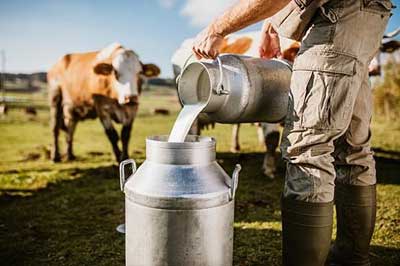Relevance: GS 3- Agricultural produce and Issues and related constraints
Key Phrases : CRISIL report,SDG 1 (zero poverty) and SDG 2(Zero hunger),Indian Grassland and Fodder Research Institute (IGFRI), Aflatoxin B1, Rashtriya Gokul Mission, E-Pashuhaat portal, backward and forward market linkages, community fodder bank
Why in the News ?
- The Covid-induced restrictions have worsened the plight of small milk producers, the organised dairy sector showed a growth rate of around only 1 per cent last fiscal — the lowest in a decade. The main reason attributed to this grim picture is the poor availability of fodder to farmers.
- Recently released CRISIL report highlighted that the sector may bounce back in 2021-22 with a projected growth rate of over 5 per cent, generating a revenue of ₹1.5-lakh crore
Background Information
- India has transformed itself from a milk deficit country to the world’s biggest milk producer over a span of three decades.
- With over 300 million bovines and producing over 198 million tonnes of milk in 2019-20, the Indian dairy sector has a strong growth potential.
Importance of Dairy Sector
- Major source of livelihood for 150 million dairy farmers. The sector contributes around 4.2% to the national gross domestic product.
- The second-largest employment sector after agriculture in India.
- Sector is a rich source of essential nutrients that contributes to a healthy and nutritious diet.
- Sector plays a vital role in global food security and poverty reduction, and in the achievement of SDG 1 (zero poverty) and SDG 2(Zero hunger) by 2030.
Major hurdles in Dairy Sector
- The major reasons for low milk productivity in India are both intrinsic (low genetic potential) and extrinsic (poor nutrition/feed management).
- Even empirical studies have shown that enhancing the quality and quantity of feed and fodder has a greater impact on increasing milk productivity than breed improvement, but still the Indian government is more focused on breed than feed.
- The lack of timely availability of nutritionally rich feed and fodder is a major factor affecting the productivity of farm animals in the country.
- As per the vision document of Indian Grassland and Fodder Research Institute (IGFRI), Jhansi, the deficit of dry and green fodder in India in 2020 was around 12 per cent and 30 per cent, respectively.
- As per a study conducted by Karnal based National Dairy Research Institute, the wholesale price index of cattle feed rose much faster than that of milk after 2012. The high volatility in prices of the ingredients is a concern.
- Firms, in order to maintain their profit margins, often resort to substitution of feed ingredients at the expense of feed quality, which has far-reaching implications not only for the productivity of the animals but also for human and livestock health.
- Moreover, limited storage capacity with firms, poor quality judgment of feed among dairy farmers and non-adherence to quality standards of feed bags (especially in the context of Aflatoxin B1 content) have led to issues such as mycotoxins in cattle feed.
Government initiatives:
- National Programme for Bovine Breeding
- Rashtriya Gokul Mission
- National Bovine Genetic Centre
- E-Pashuhaat portal
- National Programme for Dairy Development (NPDD)
- Dairy Entrepreneurship Development Scheme (DEDS)
- Dairy Processing and Infrastructure Development Fund (DIDF)
Steps need to be taken in Dairy Sector:
- Though constraints in adopting improved fodder technologies by farmers vary locally, lack of assured market for fodder is a great challenge, the government need to take sufficient steps to develop the feed market.
- With increasing government focus on genetic upgradation of cattle by cross-breeding programmes, the demand for both green and dry fodder is expected to increase exponentially, thus appropriate steps need to be taken before distress becomes a disaster.
- Climate change on productivity and production of crops in India will be huge if appropriate adaptation and mitigation measures are not taken timely.
- Various State research institutions along with the IGFRI have developed a number of improved fodder crop varieties and technologies that can ensure year round availability of quality feed and fodder for increasing animal productivity. The need is to commercialize these valuable researches.
Way Forward
- Therefore, an urgent policy need is to ensure parallel development of supporting a market environment for surplus fodder encompassing backward and forward market linkages.
- Establishing a community fodder bank where surplus fodder can be stored as fodder blocks for use during scarcity would be crucial for safeguarding the interests of small dairy farmers.
- Besides, focus on the following strategies
- Smooth credit facility for forage production
- Support price for forage and marketing of seed
- Silage innovative business model involving seed firms, supply chain functions and rural retail channels
- Strengthening extension network. These will pave the way for the Indian dairy herd achieving its full potential in the long run.
Mains Question
Q. According to many reports, it is found that India need a paradigm shift from breed focused to feed focused strategy in the Dairy Sector. In this context, analyze the performance of the Indian dairy sector. And discuss the significance of dairy sector as a driving wheel for India to achieve SDG1 and SDG 2 by 2030.( 15 marks)
Source- The Hindu BL









